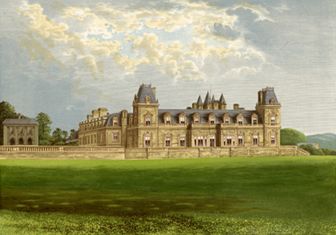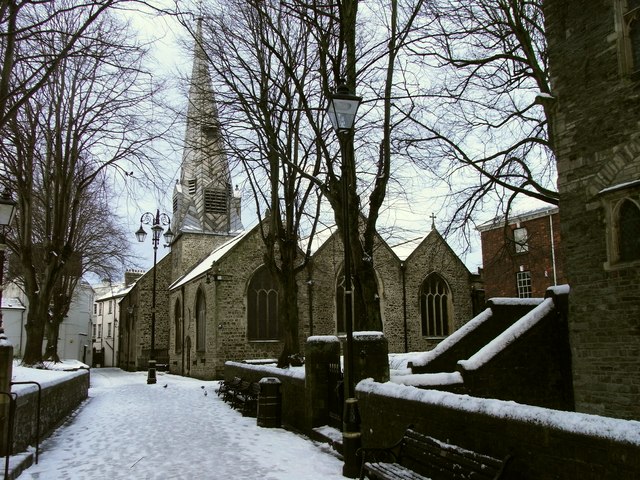|
Barnstaple Priory
The Priory of St Mary Magdalene in Barnstaple was a priory in Devon, England. It was founded in about 1107 by Juhel de Totnes, feudal baron of Barnstaple, who had earlier founded Totnes Priory in about 1087 at the ''caput'' of his former feudal barony of Totnes, from which he had been expelled. Barnstaple Priory was of the Cluniac order. It was dedicated to St Mary Magdalene. It was situated on land outside the town walls stretching from the North Gate to the East Gate with the River Yeo forming its northern boundary. Nearby to the north across the River Yeo was the Benedictine Pilton Priory of St Mary the Virgin, a cell of Malmesbury Abbey, founded slightly later, between 1107 and 1199. Endowments Juhel endowed it with part of the demesne land of Barnstaple Castle as well as with the manors of Pilton and Pilland, members of the barony, which were contiguous and situated immediately to the north across the River Yeo. The exact grant stated in the charter was one virga ... [...More Info...] [...Related Items...] OR: [Wikipedia] [Google] [Baidu] |
Barnstaple Castle
Barnstaple Castle stood near what is now the centre of the town of Barnstaple, Devon (). When it was built, it was on the western side of the fortified town and commanded a good view of both the town and its important river crossings. The castle was built on top of an early medieval cemetery. History Barnstaple Castle was founded in the 11th or 12th century; it was first mentioned in a 12th-century document. It is uncertain who founded the castle: if it was early it could have been built on the instruction of William the Conqueror as he subdued south-west England or if it was a later construction it could have been built for Juhel (Joel) of Totnes, who held the castle in the early 12th century. Juhel also established Barnstaple Priory around 1107. King Stephen granted the castle to Henry de Tracy, one of his supporters. In the 12th century, stone buildings were erected on top of the motte, possibly during Henry de Tracy's tenure. The castle descended through his family to anoth ... [...More Info...] [...Related Items...] OR: [Wikipedia] [Google] [Baidu] |
Martin Blake (clergyman)
Rev. Martin Blake (1593-1673) was vicar of Barnstaple in Devon, 1628–56; 1660–73, and suffered much for his adherence to the Cavalier, Royalist cause during the English Civil War, as related in w:John Walker (biographer), John Walker's ''Sufferings of the Clergy'' (1714). According to Chanter (1882), "The eventful history of the Rev. Martin Blake has been often written in public history and local annals". Origins This "learned and noted man" was born on 20 September 1593 in Plymouth, Devon, the second son of Nicholas Blake (1552-1645/6), merchant and Mayor of Plymouth in 1625, by his first wife Joan Goddard (d.1619) of Kingsbridge, Wiltshire. Career He was educated at Plymouth Grammar School, founded in 1561 by, amongst others, a certain William Blake, probably his grandfather. He then went to Balliol College, Oxford, shortly after in 1611 transferring to Exeter College, Oxford, especially popular with Devonshire families, where he remained for eight years. He received h ... [...More Info...] [...Related Items...] OR: [Wikipedia] [Google] [Baidu] |
English Civil War
The English Civil War or Great Rebellion was a series of civil wars and political machinations between Cavaliers, Royalists and Roundhead, Parliamentarians in the Kingdom of England from 1642 to 1651. Part of the wider 1639 to 1653 Wars of the Three Kingdoms, the struggle consisted of the First English Civil War and the Second English Civil War. The Anglo-Scottish war (1650–1652), Anglo-Scottish War of 1650 to 1652 is sometimes referred to as the ''Third English Civil War.'' While the conflicts in the three kingdoms of England, Kingdom of Scotland, Scotland and Kingdom of Ireland, Ireland had similarities, each had their own specific issues and objectives. The First English Civil War was fought primarily over the correct balance of power between Parliament of England, Parliament and Charles I of England, Charles I. It ended in June 1646 with Royalist defeat and the king in custody. However, victory exposed Parliamentarian divisions over the nature of the political settlemen ... [...More Info...] [...Related Items...] OR: [Wikipedia] [Google] [Baidu] |
Stevenstone
Stevenstone is a former Manorialism, manor within the parish of St Giles in the Wood, near Great Torrington, North Devon. It was the chief seat of the Rolle family, one of the most influential and wealthy of Devon families, from c. 1524 until 1907. The Rolle estates as disclosed by the Return of Owners of Land, 1873 (corrected by Bateman's 'Great Landowners' (1883), Bateman, 1883) comprised 55,592 acres producing an annual gross income of £47,170, and formed the largest estate in Devon, followed by the Francis Russell, 9th Duke of Bedford, Duke of Bedford's estate centred on Tavistock, Devon, Tavistock comprising 22,607 with an annual gross value of nearly £46,000. From the Glorious Revolution of 1688 to the Reform Act 1832 the county parliamentary representatives were chosen effectively from only ten great families, mostly territorial magnates. The three most dominant of these were the Baron Poltimore, Bampfyldes of Poltimore House and North Molton, the Courtenays of Pow ... [...More Info...] [...Related Items...] OR: [Wikipedia] [Google] [Baidu] |
William Howard, 3rd Baron Howard Of Effingham
William Howard, 3rd Baron Howard of Effingham (27 December 1577 – 28 November 1615) was an English nobleman, the eldest son of Charles Howard, 1st Earl of Nottingham (who as Lord Howard of Effingham famously led the English fleet against the Spanish Armada) and Catherine Carey, Lady of the chamber to Queen Elizabeth who died 25 Feb 1603 at Arundel House, Strand, Middlesex, ENG. As Sir William Howard, he was elected Member of Parliament for Surrey in 1597. However, two days before the Parliament met his father was raised to an Earldom. This meant that, as his heir, William acquired the courtesy title Lord Howard of Effingham. It seems that all concerned mistakenly believed that this disqualified him from sitting in the House of Commons, and his younger brother, Charles, was elected to replace him and sat for Surrey throughout the Parliament. However, the same mistake was not made at the next election and William represented Surrey in the Parliament of 1601. In 1603, he was su ... [...More Info...] [...Related Items...] OR: [Wikipedia] [Google] [Baidu] |
Thomas Howard, 2nd Duke Of Norfolk
Thomas Howard, 2nd Duke of Norfolk (144321 May 1524), styled Earl of Surrey from 1483 to 1485 and again from 1489 to 1514, was an English people, English nobleman, soldier and statesman who served four monarchs. He was the eldest son of John Howard, 1st Duke of Norfolk, by his first wife, Catharina de Moleyns. The Duke was the grandfather of both Queen Anne Boleyn and Queen Katherine Howard and the great-grandfather of Queen Elizabeth I. In 1513, he led the English to victory over the Scots at the decisive Battle of Flodden, for which he was richly rewarded by King Henry VIII, then away in France. Early life Thomas Howard was born in 1443 at Stoke-by-Nayland, Suffolk, the only surviving son of John Howard, 1st Duke of Norfolk, John Howard, later 1st Duke of Norfolk, by his first wife, Katherine, the daughter of William Moleyns (died 1425), Sir William Moleyns (died 8 June 1425) and his wife Margery. He was educated at Thetford Grammar School. Service under Edward IV While a ... [...More Info...] [...Related Items...] OR: [Wikipedia] [Google] [Baidu] |
William Howard, 1st Baron Howard Of Effingham
William Howard, 1st Baron Howard of Effingham (c. 151012 January 1573) was an English diplomat and military leader. He served four monarchs, Henry VIII, Edward VI, Mary I and Elizabeth I, in various official capacities, most notably on diplomatic missions and as Lord Admiral and Lord Chamberlain of the Household. Early life William Howard was born about 1510, the ninth son of Thomas Howard, Earl of Surrey, later 2nd Duke of Norfolk. He was the eldest son of Surrey by his second wife, Agnes Tilney. Howard was brought to court at a young age after completing his education at Trinity Hall, Cambridge. Embassies In 1531, Howard was sent on an embassy to Scotland by King Henry VIII, and accompanied the King to Boulogne in October 1532. In May 1533, as deputy to his half-brother, Thomas Howard, 3rd Duke of Norfolk, he served as Earl Marshal at the coronation of his niece, Anne Boleyn, the daughter of his half-sister, Elizabeth Boleyn, Countess of Wiltshire. On 10 Septe ... [...More Info...] [...Related Items...] OR: [Wikipedia] [Google] [Baidu] |
Henry VIII Of England
Henry VIII (28 June 149128 January 1547) was King of England from 22 April 1509 until his death in 1547. Henry is known for his Wives of Henry VIII, six marriages and his efforts to have his first marriage (to Catherine of Aragon) annulled. His disagreement with Pope Clement VII about such an annulment led Henry to initiate the English Reformation, separating the Church of England from papal authority. He appointed himself Supreme Head of the Church of England and dissolution of the monasteries, dissolved convents and monasteries, for which he was List of people excommunicated by the Catholic Church, excommunicated by the pope. Born in Greenwich, Henry brought radical changes to the Constitution of England, expanding royal power and ushering in the theory of the divine right of kings in opposition to papal supremacy. He frequently used charges of treason and heresy to quell dissent, and those accused were often executed without a formal trial using bills of attainder. He achi ... [...More Info...] [...Related Items...] OR: [Wikipedia] [Google] [Baidu] |
St Peter's Church, Barnstaple
St Peter's Church is the parish church of the town of Barnstaple in North Devon, England. Parts of the church date to the 13th-century with much restoration during the Victorian era by George Gilbert Scott and later by his son John Oldrid Scott which changed the atmosphere of the building, although many fine wall monuments and tablets remain. The church comes under the Diocese of Exeter. History Æthelstan is said to have granted Barnstaple its first Charter in 930 AD and it is believed a church may have existed here then. The town received subsequent Charters in 1154, 1189, 1201 and 1273. The first recorded Rector was Walter Treasurer of Exeter (1257) and the first stone church probably dates from this time.David Spurr, ''Devon Churches: Bideford, Barnstaple and the Hartland Peninsula'' Vol 1, Merlin Books (1983) pg 15-16 Fragments of the tower are late 13th-century, as are parts of the chancel, although the latter was raised and widened when the north and south aisles were ad ... [...More Info...] [...Related Items...] OR: [Wikipedia] [Google] [Baidu] |
Domesday Book
Domesday Book ( ; the Middle English spelling of "Doomsday Book") is a manuscript record of the Great Survey of much of England and parts of Wales completed in 1086 at the behest of William the Conqueror. The manuscript was originally known by the Latin name , meaning "Book of Winchester, Hampshire, Winchester", where it was originally kept in the royal treasury. The ''Anglo-Saxon Chronicle'' states that in 1085 the king sent his agents to survey every shire in England, to list his holdings and dues owed to him. Written in Medieval Latin, it was Scribal abbreviation, highly abbreviated and included some vernacular native terms without Latin equivalents. The survey's main purpose was to record the annual value of every piece of landed property to its lord, and the resources in land, labour force, and livestock from which the value derived. The name "Domesday Book" came into use in the 12th century. Richard FitzNeal wrote in the ( 1179) that the book was so called because its de ... [...More Info...] [...Related Items...] OR: [Wikipedia] [Google] [Baidu] |





